Disclosure: Meeple Mountain received a free copy of this product in exchange for an honest, unbiased review. This review is not intended to be an endorsement.
“I am Adam, Prince of Eternia, Defender of the secrets of Castle Grayskull…and this is Cringer.”
I can’t tell you how many Saturday mornings (and, eventually, syndicated afternoons) began with that line. I also can’t tell you how many dollars my parents must have spent outfitting my childhood with everything the He-Man marketing machine could churn out. Ah, there’s nothing like the smell of cartoons developed specifically as 22-minute advertisements—two glorious 65-episode seasons that, despite the lackluster animation, somehow survived years of airtime.
How fitting, then, to have Adam, Prince of Eternia, introduce Masters of the Universe: Clash for Eternia with nearly the same sentence. The nostalgia kick that began before I tore the shrink only continued as I took my first peek into the rulebook.
Masters of the Universe (MotU from here on out) is a tactical one-versus-all skirmish game from Michael Shinall, Leo Almeida, and the publishing team at CMON. Players take up their favorite heroes and baddies from the beloved 80s cartoon universe to engage a series of standalone Scenarios.
Regardless of my affinity for the deep dive into trademarked waters, it is the Power System—the mechanisms that form the backbone of the game experience—that really shines with MotU. Mark my words, this is not the last you’ll hear of the Power System. I can all but guarantee it will soon be coming to an intellectual property—one likely born on a Saturday morning in the 1980s—near you.
The Power System
Controller and Player(s)
One player assumes the role of the Controller, taking three characters with all their cards and miniatures. In addition, the Controller begins with a special Strategy board that offers support to the characters and control of a series of Minions.
The delightfully chunky plastic player board has molded slots for each character’s base card and recessed slots for the Strategy basics. These cards describe base abilities, special skills, and bonus actions that supply the action across the six-fold board of hexagonal spaces. As the game Scenario escalates, the characters receive a power-up and the Strategy basics all flip to reveal a more beefy selection of actions.
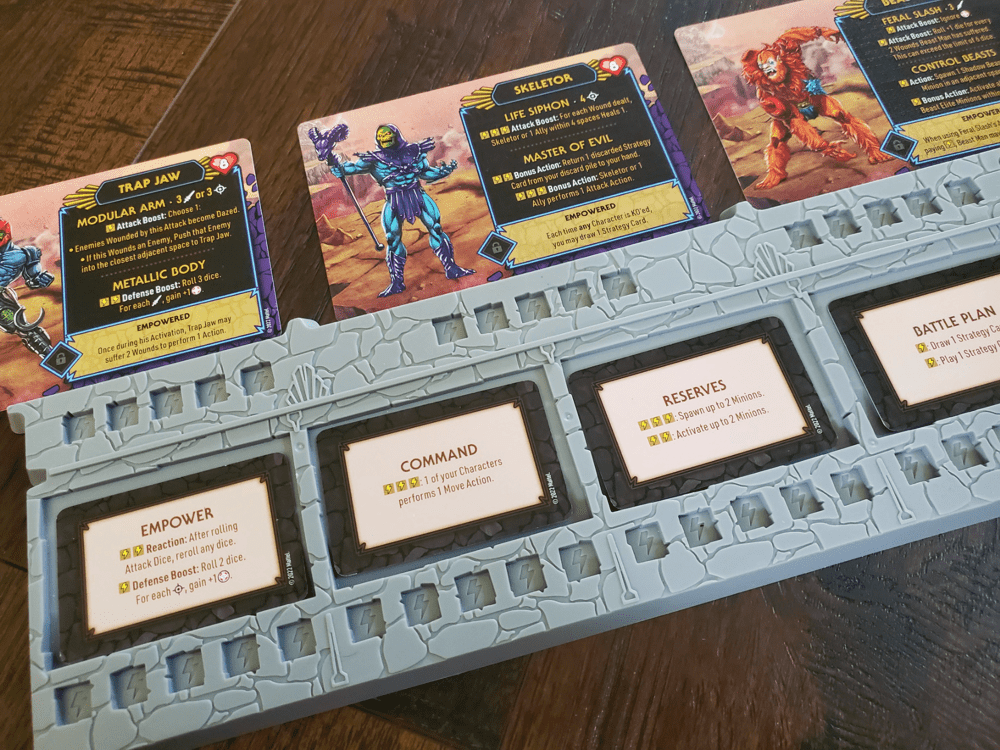
Some combination of others assume Player roles for the opposition. (In most Scenarios the heroes and the baddies are interchangeable, allowing for a high level of variety and versatility.) The key here is the number four. In each round the Players—and the Controller—will activate four times. For the Players, this could be four different characters, three characters with a wild (so to speak), or two characters that each activate twice. The number of humans across the table really doesn’t matter. It just depends how much discussion you enjoy, how much shouting you might like to elicit, and how much down time you’d like everyone to endure.
Each Player character has a base card and three escalating power-up cards. These cards become active as the Scenario’s story arc progresses, unleashing ridiculous powers until the game reaches its furious conclusion.
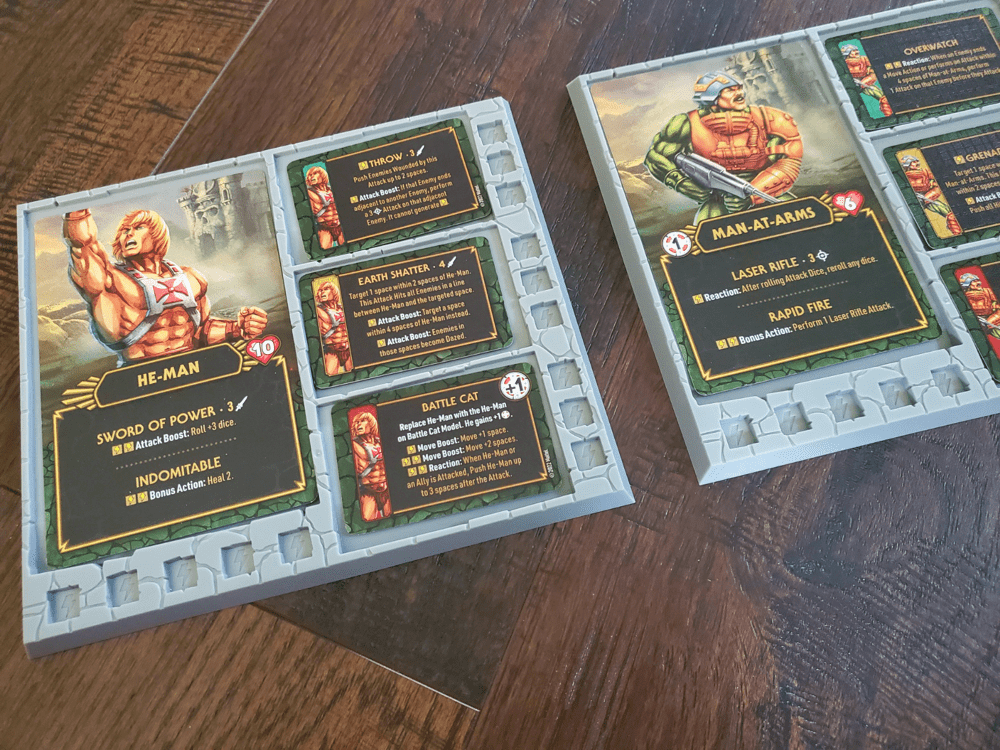
Progression
In each round, both Controller and Player(s) lay cards corresponding to their characters in alternating spaces along an activation track. One by one the cards are flipped and the characters brought to life. As the round progresses, activated characters receive an increasing number of Energy cubes, the fuel behind the brand-specific fire.
![]()
The character then performs two actions: Move up to three hex spaces, Attack against an enemy in range and line of sight, or Interact with something on the board. Sometimes a Skill requires an action to employ, but the card will always say so.
The Movement rules are mostly intuitive. It costs an extra movement to ascend or descend rocks, enter or exit the forest, or enter one of Mer-Man’s annoying little puddles (which also stop you dead in your tracks). The quirk here is Escape Damage. Any time a character moves when directly adjacent to an enemy, that character receives a wound for each adjacent enemy. In other words, running away—or even side-stepping for a better position—comes at a price.
Attacking is a dice-chucking delight. The dice boast swords, targets, and Castles Grayskull. Melee attacks require swords, Range attacks targets, and Castles always count as a success. Some characters possess a shield that blocks a number of successful dice, but there is little active defense in MotU—you mostly take what you’re given. Wounds are tracked via character tokens on the activation board.
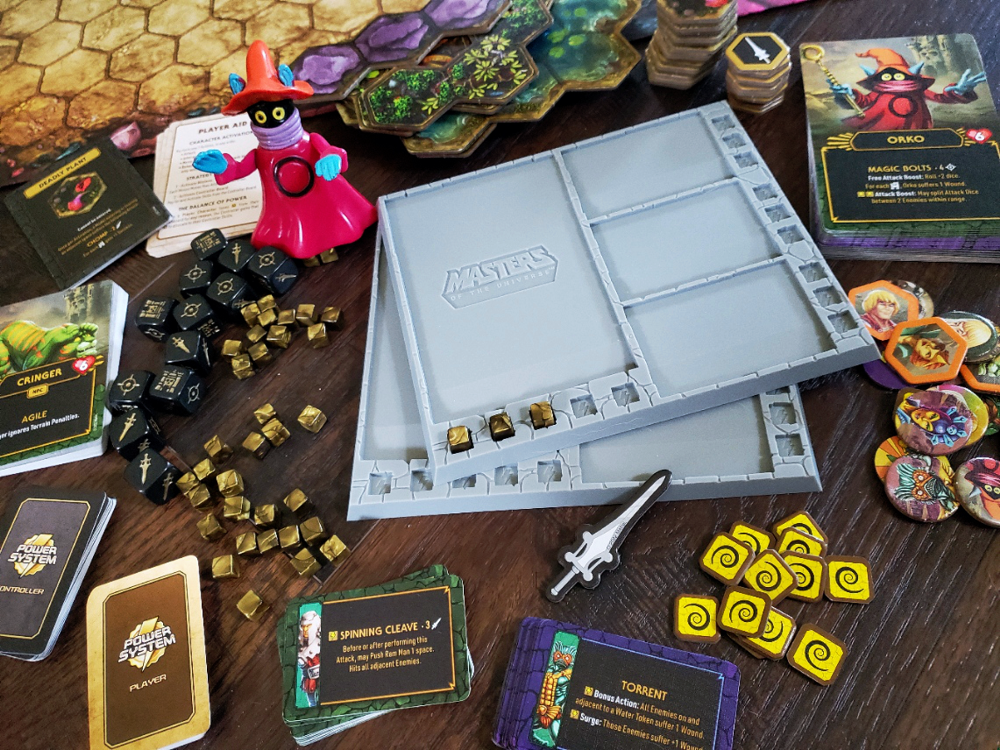
Characters often have Bonus Actions that don’t count against the allotted 2. Surges likewise come as post-attack boosts. The cost for all of this personality is Energy. In a beautiful balancing act, Energy spent by Player characters is paid not to the supply but to the Controller for the activation of their Strategy board. Ouch!
The Scenarios
All of this takes place on a rather large blank map that is populated with Terrains and tokens according to the Scenario guide. MotU comes with forests, rocks, poison plants, boulders (that can be THROWN—did you hear me, people?!), ruins, and more (depending on the depth of the wallet) to add challenge and dimension to each situation.

Some of the Scenarios are straight dog fights—secure KOs and claim the victory. Others are capture-the-flag situations—burn down the magical forest, get the prize, and get out. Some are delivery missions—get the Queen across the map…alive.
Every Scenario has a set of conditions that escalate the narrative and activate all those juicy abilities to keep life interesting. The map layouts are crystal clear, the tokens are easy to read, and the fun is ever-waiting.
I HAVE THE POOWWWEERRRRR!
Before I even get to He-Man, the game system is a winner. The activation track is a beautiful way to progress a story. The immediate need is held in constant tension with the need for Energy. Yes, you can have any character you want for your first activation, but you receive no aid (or nearly none) in the effort. This alone is a lovely head game for the Controller and an ever-present conversation for the Players.
I’m not sure how many games use one character’s spent Energy to fuel the opposition, but this may be the most exquisitely frustrating design in the mix. No, I don’t want to give the deranged game master over there three more Energy, but I REALLY want to use this mind control thing to totally mess up her life. These are the whispers that echo in the mind of the Player team and the conflicts that inject the decisions with vitality.
As far as the base design is concerned, its simplicity allows for such great engagement. Move and attack, move and attack, attack, attack, ATTACK!!! Occasionally there’s more, but for the most part it’s move and do absurd super-things to your enemy. I love it.
The versatility within the player counts is also refreshing. I’ve mostly enjoyed two players and it’s a great balance as each player fires off action-packed turn after action-packed turn with a mix of characters. One vs. two or three is great because of the attempts at cryptic strategic conversation while the Controller sits and smiles—or sweats, depending on the board state.
Truth is, there’s a lot to love.
The tried and true way…we’ll cheat!
But what about He-Man? The actual Masters of the Universe are both the most satisfying and most frustrating aspect of the game.
The miniatures are super fun. They’re not quite as chunky as the pieces from Marvel United. They hang out more in the realm of Unmatched or Star Wars: Epic Duels—by no means fragile, but more delicate than thick. They’re light for a guy who grew up on the sort of action figures that had ligaments thicker than that of some small children, but they’ll do. They scratch the right itch.
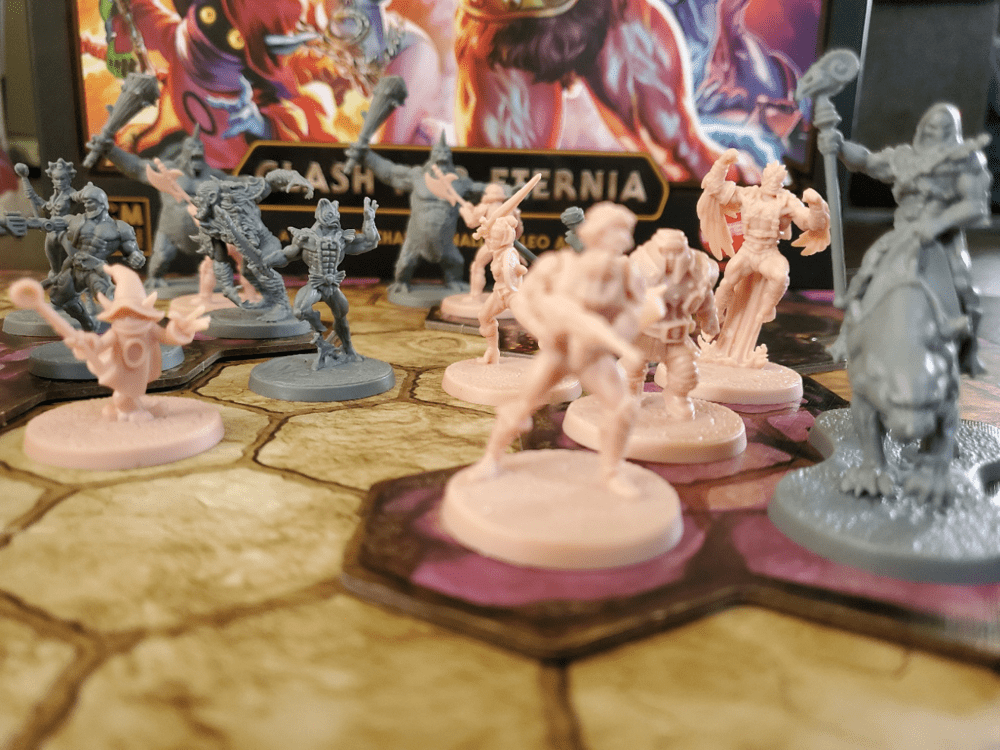
The card art is spectacular—no 1980s animation here. Every illustration is a masterpiece for the MotU portfolio. The same artwork dots the rulebook and the Scenario book, lending a bit of personality to the components that are referenced most.
The dice are classic black with gold iconography. For all the rolling, they roll well and keep the battles lively. The Energy cubes are pretty and just unique enough to make handing them across the table hurt. When the game is set up on the (preferably large) table, it is a sight. I didn’t have access to the 3D materials or the expansion replica of Castle Grayskull, but even the flat cardboard bits are sturdy.
So yes, He-Man is great. But…
But the rulebook can’t possibly handle all of the edge cases that a game like this inevitably raises. The base game comes with six heroes and six baddies, plus a slew of minions, elite minions, plus a mounted version of He-Man (with Battle Cat) and Skeletor (on Panthor). Each character has a set of attacks, (more rarely) defenses, abilities, skills, surges. Each of the twenty Scenarios combines 10-15 Terrain bits and tokens as a playground for the unique combination of…everything.
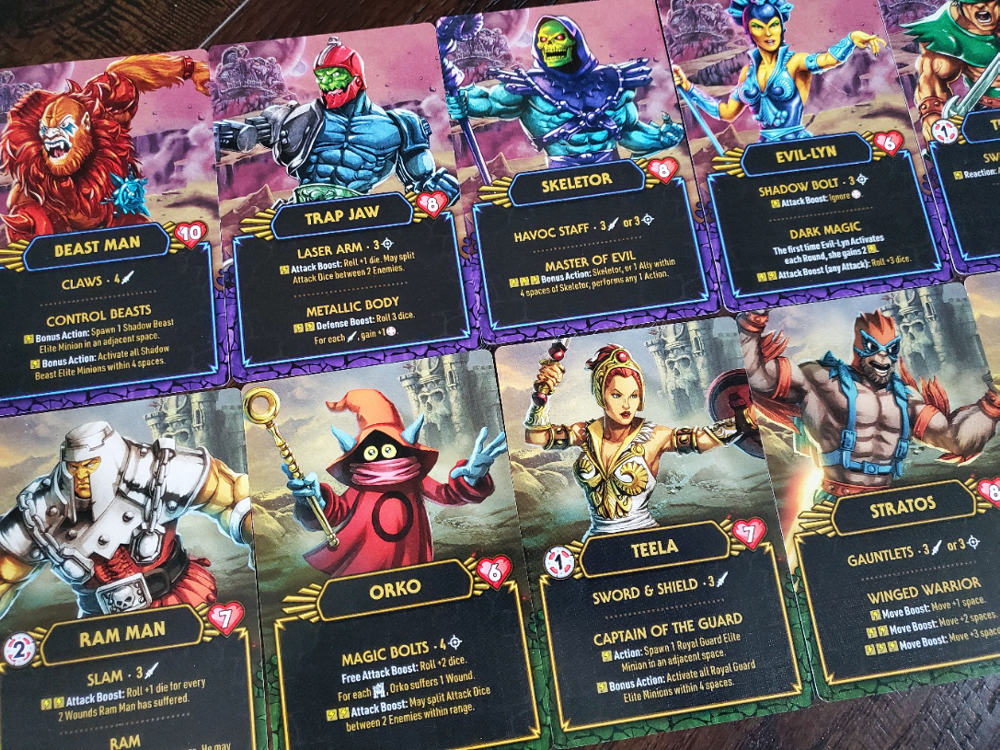
The game system is highly intuitive and—I would argue—nearly everything makes sense before the edge cases drop. There are two ways, then, to approach the game. You could worry over many things. You could obsess over whether a CMON representative has approved everything that everyone is doing in every obscure moment, extending your game sessions by minutes or hours. OR you could trust your intuition, make decisions that make sense in the moment and worry about it later. As of this writing, mere weeks after the initial release, there are already 400+ comments in the database on BGG. There are so many combinations in the aether that your worry might not even be there yet. Personally, I don’t fret about edge cases and I’m not concerned with labeling every victory with an asterisk if it comes out later that we did something “wrong” in the seventh round. But I’ve often wondered if I’m not just a bit too casual.
I like getting a tan, but this is ridiculous…
When 8,166 backers gave over $2million toward the creation of MotU, there were four game expansions in the mix with the Grayskull-sized grab bag of plastic extras. For this review, I had access to She-Ra and the Great Rebellion and The Evil Horde.
Without sounding too reductionistic, every box is more of everything I’ve said already. Six more characters with all their corresponding cards and extras, a pile of minions, and one character with a mounted variation. As physical specimens, they’re excellent. In the gameplay system, they all add their own distinct gleams and wrinkles. More is just…more, whether it be the solid center or the murky fringe.
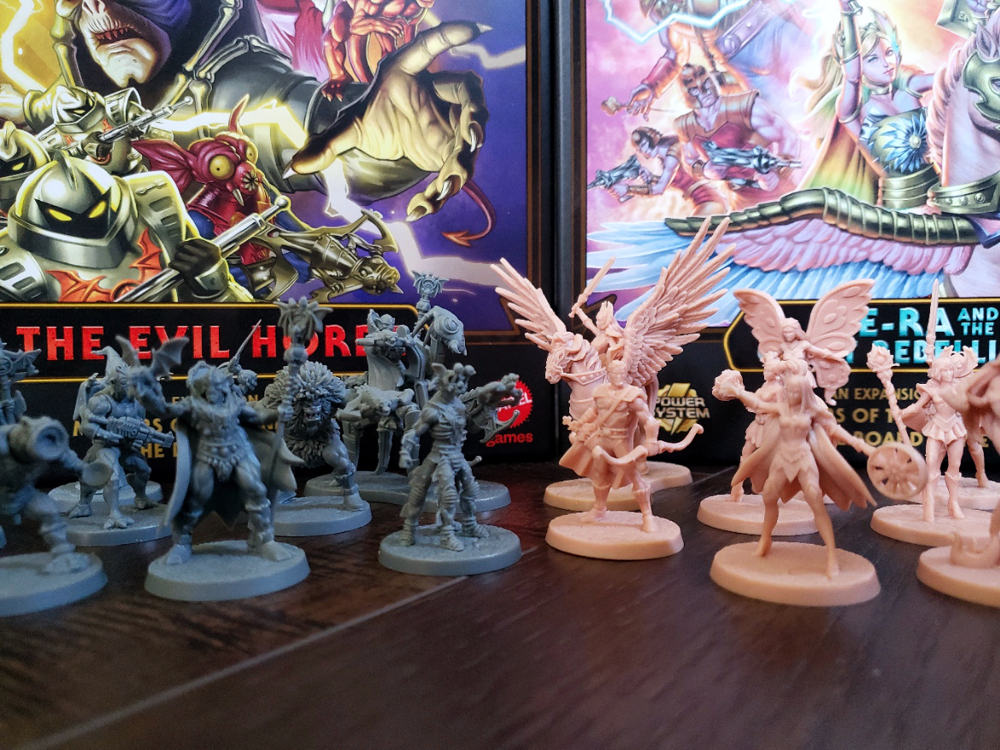
I wish I could play with all of the plastic Eternian goodness, but I’m pretty content to play with the cardboard. I can see this universe expanding until they’re out of He-Man material. But I can also see every other Saturday-morning universe dipping their toes in the Power System waters. Down the road, I can see super-fans creating Scenario books in which G.I. Joe teams up with the Ninja Turtles to take on the Controller from Transformers, M.A.S.K, Animaniacs, or the Jetsons. And I would guess that in every case the review would be similar. The system works. The minis are good. The art is amazing. The edge cases are many, but it’s fun! It’s fun.
Just what everyone needs, a magical island holiday…
So there I was, trying to help Queen Marlena escape from the ruins to the other side of Eternia. He-Man, Ram Man, and Orko were in the fray among the Eternian soldiers. Shadow Weaver (and her minions), Beast Man (and his minions), and Mer-Man had completely thwarted our attempt to leave the enclosed caves. Not only that, Mer-Man had spread his ridiculous little puddles making it nearly impossible to move. Fur-face and Fish-face were standing right next to the Queen and two measly minions. In the next round I would be toast.
On my Strategy turn, I was able to knock out Beast Man, who had suffered more than a few wounds from He-Man outside, with a minion. Not only that, but the Queen herself knocked out Mer-Man and I was safe for a few turns. But practically, I still couldn’t get out. I had to try for victory by KOs
They closed in again quickly and everything looked grim. They were literally standing at the door with no one left standing guard. Again, I was one nasty turn from destruction.
Enter Ram Man. I used his ridiculous special attack to rush through three enemies, right into the puddle between the bad guys and the Queen. They were wounded, dazed, and kicked back from their prime positions. One was now adjacent to He-Man and the other had to go through the Ram. Thankfully, Orko and a pile of minions were causing problems for the Shadow Weaver across the way. What a turn!!

These are the sorts of episodes that litter a well-played game of Masters of the Universe: Clash for Eternia. It’s just plain fun, and there are stories to tell. When the dust settles, we see how folks are treating the edge cases, but we don’t worry in the moment and we don’t cry about it after. In time we may do everything right for every character on every turn, but in the meantime intuition is sufficient, and there’s simply too much to enjoy. If you’re into this sort of game, you won’t be disappointed. The base box has plenty, and there’s plenty more where that came from if you’re hungry for new faces.
Now if you’ll excuse me, I’ll just be taking this magic sword and holding it aloft…by the power of Grayskull!!





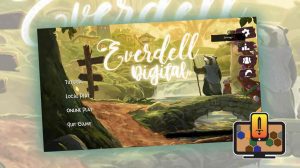






Add Comment